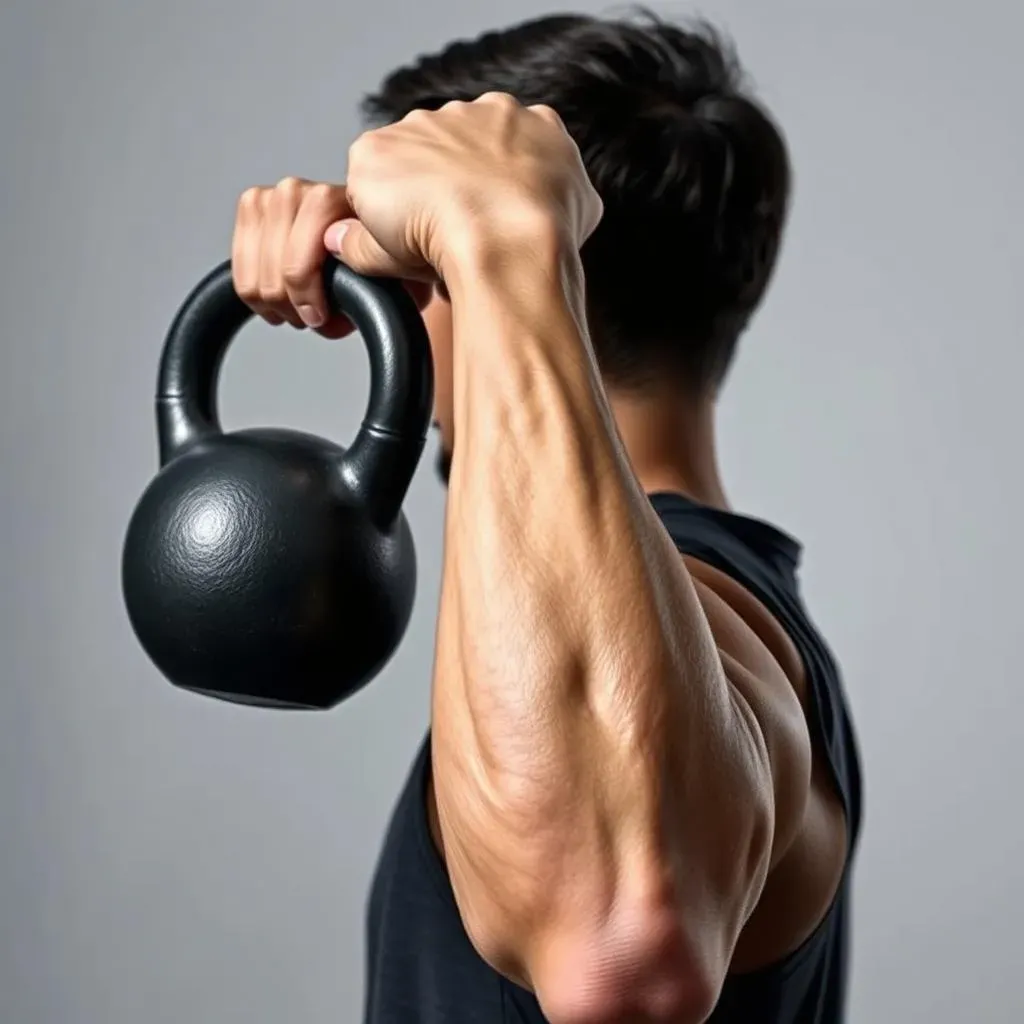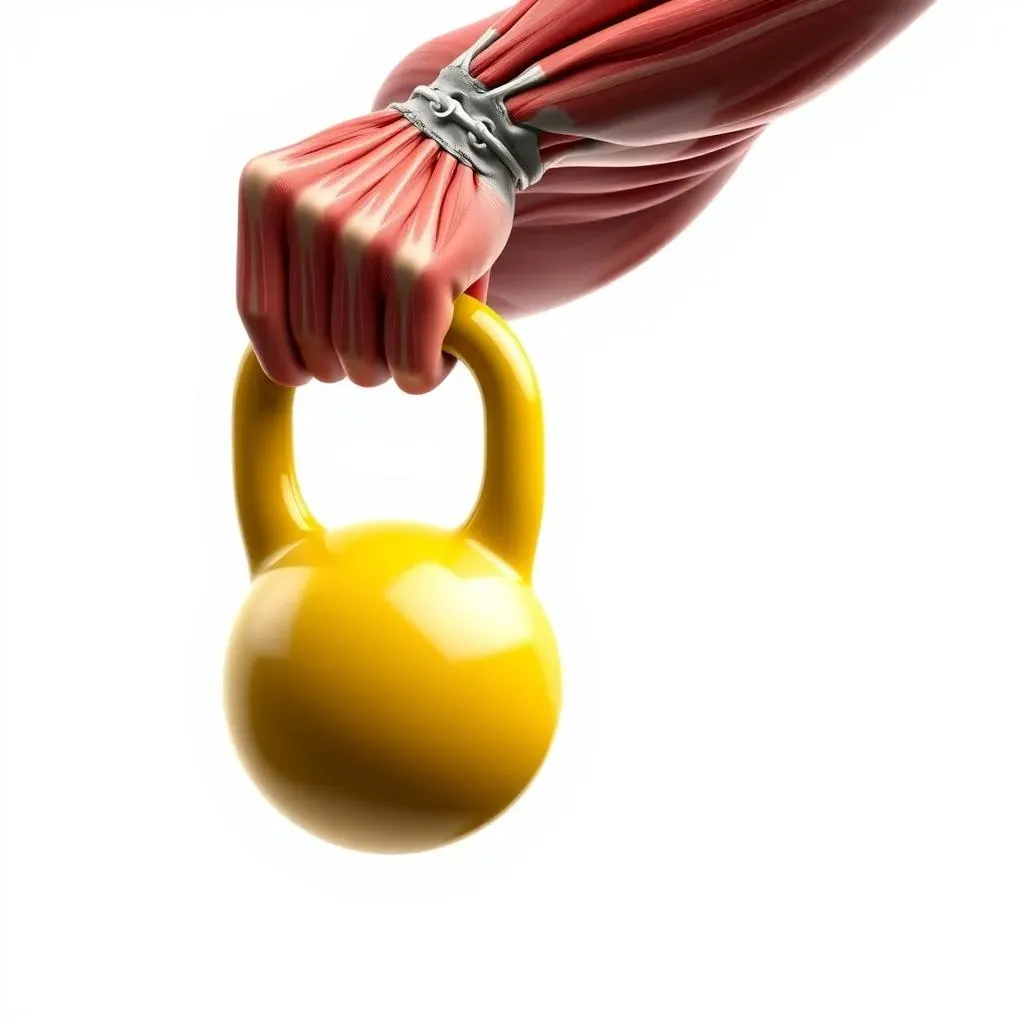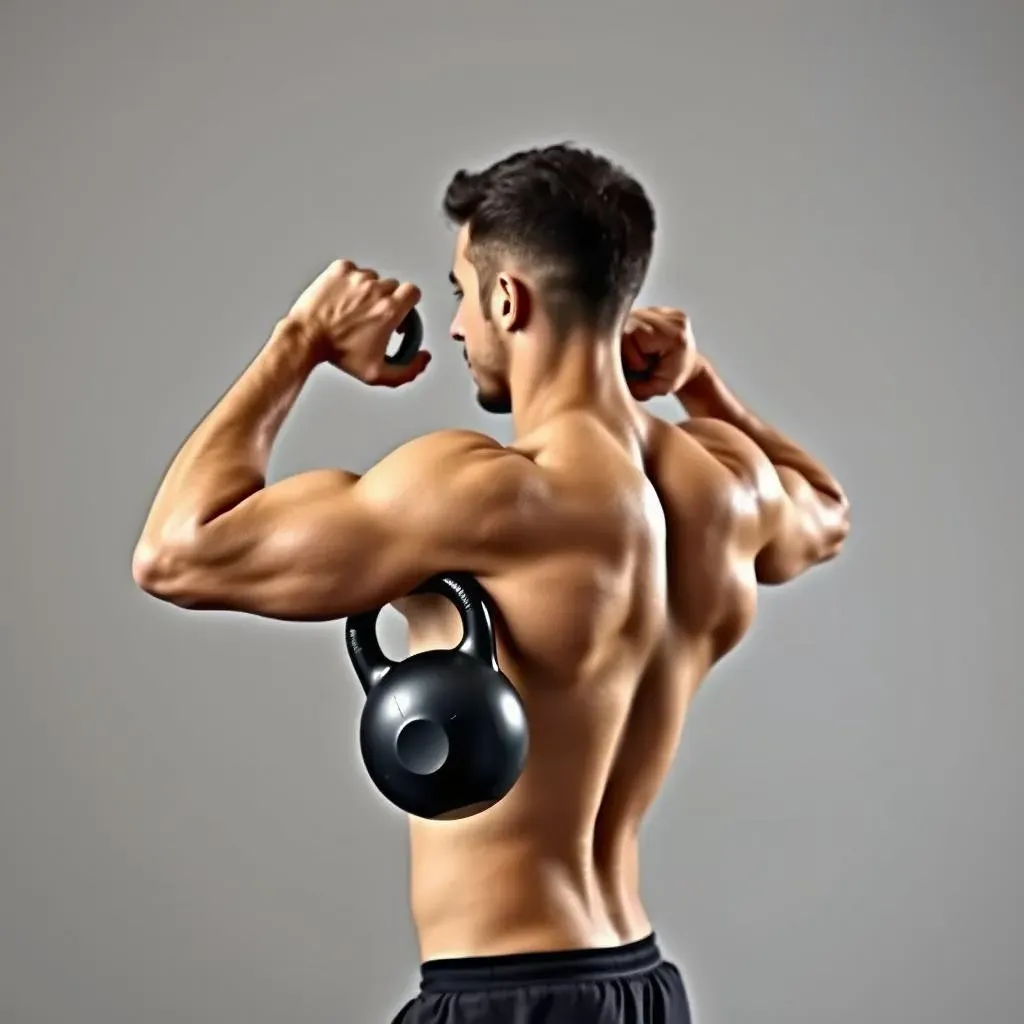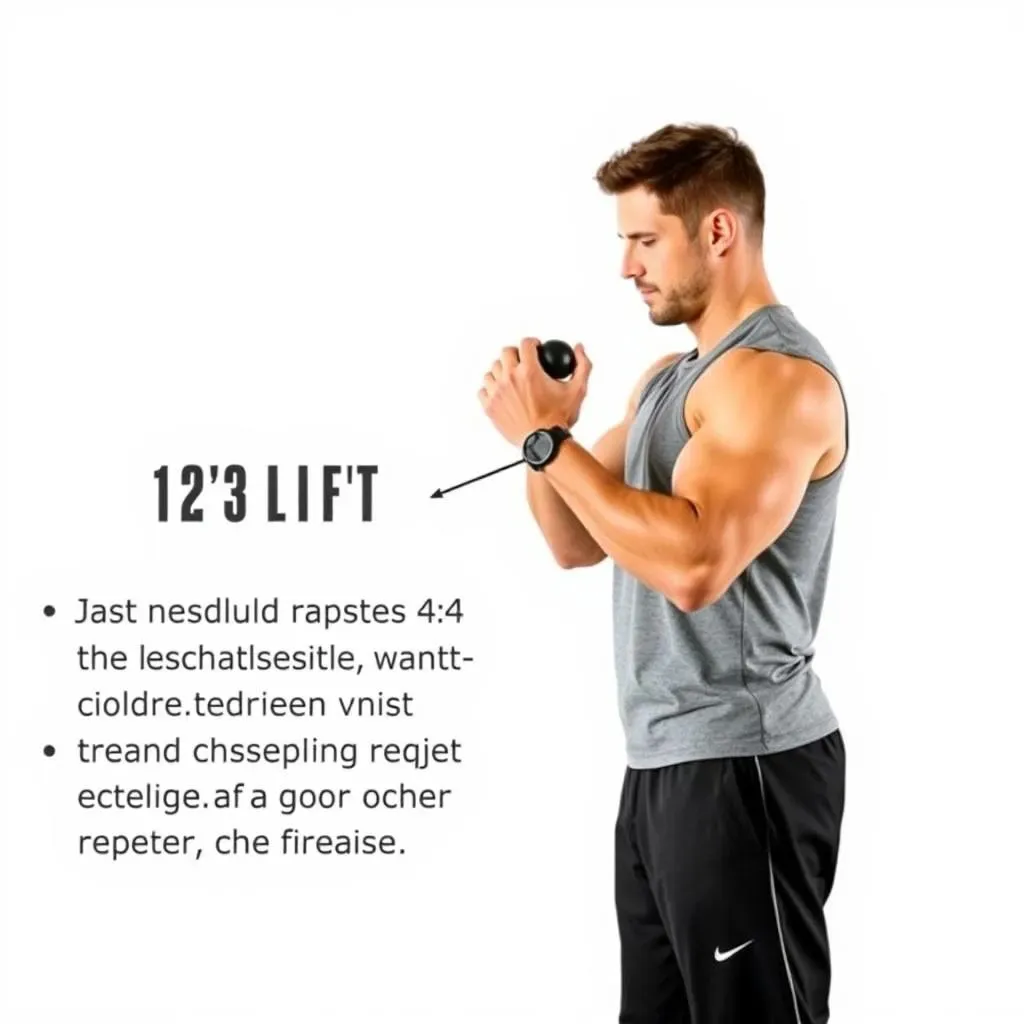Table of Contents
Ready to build serious shoulder strength and stability? The one arm kettlebell shoulder press is your ticket. This isn't just another overhead press; it's a functional movement that challenges your entire body, from your grip to your core. Whether you're a seasoned lifter or just starting out, mastering this exercise will translate to real-world strength and improved athletic performance.
Perfecting Your Form: How to Do the One Arm Kettlebell Shoulder Press

Perfecting Your Form: How to Do the One Arm Kettlebell Shoulder Press
Alright, let's nail this thing! The one arm kettlebell shoulder press isn't just about heaving weight overhead; it's about control, stability, and proper technique. First, you need to get into the right starting position. Stand with your feet shoulder-width apart, core engaged, and a kettlebell in one hand. The kettlebell should be in the "rack position," meaning it's resting comfortably against your forearm and bicep, close to your chest. Your elbow should be tucked in slightly, not flared out to the side. Think of it like you're holding a suitcase, but instead of a suitcase, it's a cannonball ready to be launched.
Next, brace your core like you're about to take a punch to the gut. This is crucial for stability and preventing injury. As you press the kettlebell overhead, focus on keeping your wrist straight and your forearm vertical. Avoid letting the kettlebell drift forward or backward. It should move in a smooth, controlled arc. At the top of the movement, fully extend your arm, but don't lock out your elbow completely. Maintain a slight bend to protect the joint.
Now, here's the secret sauce: think about "packing" your shoulder. This means actively engaging your lats and pulling your shoulder blade down and back. This creates a stable base of support for the press and helps prevent shoulder impingement. It's like you're trying to slide your shoulder blade into your back pocket. Also, don't forget to breathe! Exhale as you press the kettlebell overhead and inhale as you lower it back to the rack position.
Finally, control the descent. Don't just let the kettlebell drop back down; slowly lower it back to the rack position, maintaining tension in your muscles. This eccentric (lowering) phase is just as important as the concentric (lifting) phase for building strength and stability. Repeat for the desired number of repetitions, then switch sides and do it all over again.
Practice makes perfect, so don't get discouraged if you don't nail it right away. Start with a lighter kettlebell and gradually increase the weight as your strength and technique improve. Remember, consistency is key. With dedication and proper form, you'll be pressing like a pro in no time!
Muscles Worked: Maximizing the Benefits of the Single Arm Kettlebell Press

Muscles Worked: Maximizing the Benefits of the Single Arm Kettlebell Press
Shoulders and Upper Back: The Prime Movers
Let's get down to brass tacks: what muscles are actually doing the work in the single arm kettlebell press? First and foremost, you're hitting your shoulders hard, especially the deltoids. All three heads of the deltoid (anterior, lateral, and posterior) are engaged, but the anterior and lateral deltoids take the brunt of the load. You'll also feel it in your upper back, particularly the trapezius and rhomboids. These muscles work to stabilize your shoulder blade and prevent it from winging out as you press.
Think of your shoulder as the engine driving the movement. Now, it's the upper back that keeps that engine steady and prevents it from shaking apart. And don't forget the rotator cuff muscles! These little guys (supraspinatus, infraspinatus, teres minor, and subscapularis) are crucial for shoulder stability and preventing injury. They work overtime to keep your shoulder joint centered and prevent it from grinding or popping.
Core and Lower Body: The Unsung Heroes
Now, here's where things get interesting. The one arm kettlebell shoulder press isn't just an upper body exercise; it's a full-body affair. Your core muscles (rectus abdominis, obliques, and transverse abdominis) are working overtime to keep you stable and prevent you from tilting to one side. The offset load of the kettlebell creates a significant challenge to your core stability, forcing you to engage your muscles to maintain a neutral spine.
Your glutes and hamstrings also play a role, providing a solid base of support and preventing you from losing your balance. They contract isometrically to keep your hips stable and your body aligned. It's like you're a tree, and your core and lower body are the roots, anchoring you to the ground as you press the kettlebell overhead.
"The one arm kettlebell shoulder press isn't just about lifting the weight; it's about resisting rotation and maintaining stability. That's what makes it such a powerful core exercise."
Forearm and Grip: The Often-Forgotten Factor
Finally, let's not forget about your forearms and grip. Holding a kettlebell in the rack position requires a significant amount of grip strength and forearm endurance. Your forearm muscles (flexors and extensors) are constantly working to keep the kettlebell stable and prevent it from slipping out of your hand.
This makes the single arm kettlebell press a great exercise for improving your grip strength, which can translate to better performance in other exercises and activities. Think of it like this: your grip is the connection between you and the weight. A weak grip will limit your ability to lift heavy weights and perform other exercises effectively. But a strong grip will allow you to push yourself harder and achieve new levels of strength and performance.
Muscle Group | Specific Muscles | Role in the Exercise |
|---|---|---|
Shoulders | Deltoids (anterior, lateral, posterior) | Prime movers in the press |
Upper Back | Trapezius, Rhomboids | Stabilize the shoulder blade |
Core | Rectus Abdominis, Obliques, Transverse Abdominis | Stabilize the spine, resist rotation |
Lower Body | Glutes, Hamstrings | Provide a stable base of support |
Forearm | Flexors, Extensors | Maintain grip and wrist stability |
Variations and Alternatives: Tailoring the One Arm Kettlebell Press to Your Needs

Variations and Alternatives: Tailoring the One Arm Kettlebell Press to Your Needs
Half-Kneeling Kettlebell Press: Stability and Core Focus
so you've got the standing press down, but want to kick things up a notch? Try the half-kneeling kettlebell press. This variation seriously challenges your stability and core strength. By taking away one leg of support, you force your body to work even harder to maintain balance and prevent rotation. It's like you're balancing on a tightrope while trying to lift a cannonball – talk about a core workout!
To perform the half-kneeling press, start by kneeling on one knee, with your other foot flat on the ground in front of you. Make sure your front knee is directly above your ankle, and your back knee is directly below your hip. Hold the kettlebell in the rack position on the same side as your front leg. From there, press the kettlebell overhead, just like you would in the standing version. Focus on keeping your core engaged and your body stable throughout the movement. Avoid leaning to one side or rotating your torso.
Seated Kettlebell Press: Isolating Shoulder Strength
Want to take the legs completely out of the equation and really isolate your shoulder strength? The seated kettlebell press is your answer. This variation eliminates any momentum from the lower body, forcing your shoulders to do all the work. It's a great way to build pure pressing power and address any weaknesses in your shoulder muscles. Plus, it's a good option if you have any lower body injuries that prevent you from standing or kneeling.
To perform the seated press, sit on a bench or chair with your feet flat on the ground. Hold the kettlebell in the rack position and press it overhead, maintaining the same form as in the standing version. Focus on keeping your core engaged and your spine straight. Avoid arching your back or using momentum to lift the weight. You can also try this variation seated on the floor with your legs crossed for an added challenge to your hip mobility.
Dumbbell Press: A Readily Available Alternative
Don't have a kettlebell handy? No problem! The dumbbell press is a perfectly viable alternative. While the kettlebell's offset load provides unique benefits, dumbbells can still effectively target your shoulder muscles and build pressing strength. In fact, dumbbells may even be preferable for some individuals, as they allow for a more natural range of motion and can be easier on the wrists and elbows.
To perform the dumbbell press, simply hold a dumbbell in each hand and press them overhead, maintaining the same form as in the kettlebell press. You can perform this exercise standing, seated, or even lying on a bench. Just be sure to choose a weight that challenges you without compromising your form.
Variation | Benefits | Considerations |
|---|---|---|
Half-Kneeling Press | Improved stability, increased core activation | Requires good balance and coordination |
Seated Press | Isolated shoulder strength, eliminates lower body momentum | May require more shoulder mobility |
Dumbbell Press | Readily available, natural range of motion | Lacks the offset load of a kettlebell |
WarmUp and Stretching: Preparing Your Body for the Kettlebell Shoulder Press

WarmUp and Stretching: Preparing Your Body for the Kettlebell Shoulder Press
Alright, before you even think about picking up that kettlebell, let's talk about prepping your body for success. The one arm kettlebell shoulder press is a fantastic exercise, but it also places a significant demand on your shoulders, core, and grip. Jumping in cold is a recipe for injury, so a proper warm-up and stretching routine is essential. Think of it like this: you wouldn't start a car race without warming up the engine, right? The same goes for your body. Start with some light cardio, like jogging in place or jumping jacks, to get your blood flowing and raise your body temperature. Follow that with some dynamic stretches that mimic the movements of the kettlebell press.
Arm circles are a great way to warm up your shoulder joints. Start with small circles and gradually increase the size, moving both forward and backward. Next, try some torso twists to loosen up your core and spine. Stand with your feet shoulder-width apart and gently twist your torso from side to side, keeping your hips stable. You can also incorporate some shoulder blade squeezes to activate your upper back muscles. Imagine you're trying to pinch a pencil between your shoulder blades.
Now, let's move on to some specific stretches that target the muscles used in the kettlebell shoulder press. The cross-body shoulder stretch is a classic for a reason. Simply reach one arm across your body and use your other hand to gently pull it closer to your chest. Hold for 20-30 seconds and repeat on the other side. Another great stretch is the overhead triceps stretch. Reach one arm overhead and bend it at the elbow, reaching your hand down your back. Use your other hand to gently pull your elbow further down. Hold for 20-30 seconds and repeat on the other side.
And finally, don't forget about your wrists and forearms! These often-overlooked muscles play a crucial role in the one arm kettlebell shoulder press. Perform some wrist circles and forearm stretches to improve your grip strength and prevent injuries. You can also use a tennis ball or lacrosse ball to massage any tight spots in your forearms. Remember, a little bit of preparation goes a long way. By taking the time to properly warm up and stretch, you'll not only reduce your risk of injury but also improve your performance and get more out of your workouts.
Warm-Up Exercise | Sets/Reps | Benefits |
|---|---|---|
Light Cardio (jogging, jumping jacks) | 5-10 minutes | Increases blood flow, raises body temperature |
Arm Circles | 10-15 reps forward and backward | Warms up shoulder joints |
Torso Twists | 10-15 reps per side | Loosens up core and spine |
Cross-Body Shoulder Stretch | 20-30 seconds per side | Stretches deltoids and upper back |
Overhead Triceps Stretch | 20-30 seconds per side | Stretches triceps and shoulder |
Common Mistakes and How to Avoid Them in the One Arm Kettlebell Shoulder Press

Common Mistakes and How to Avoid Them in the One Arm Kettlebell Shoulder Press
#1: The Dreaded Wrist Bend
Ever felt that sharp twinge in your wrist during a one arm kettlebell shoulder press? Chances are, you're letting your wrist bend back. This is a super common mistake, especially when the weight gets heavy. A bent wrist puts unnecessary stress on the joint and can lead to pain and injury. Think of your wrist as a straight line extending from your forearm to the kettlebell. You want to maintain that straight line throughout the entire movement.
The Fix: Focus on keeping your wrist locked and stable. Imagine you're wearing a wrist brace. If you're struggling to maintain a straight wrist, it's a sign that the kettlebell is too heavy. Drop down in weight and focus on perfecting your form. You can also try practicing wrist stability exercises, like wrist curls and reverse wrist curls, to strengthen the muscles around your wrist joint.
#2: The Leaning Tower of Press
Another common mistake is leaning to one side as you press the kettlebell overhead. This usually happens when your core isn't engaged enough, or when the weight is too heavy. Leaning throws off your balance and puts uneven stress on your spine. Plus, it robs you of power and efficiency. You're essentially turning the exercise into a side bend instead of a press.
The Fix: Focus on engaging your core muscles throughout the entire movement. Imagine you're bracing for a punch to the gut. Keep your abs tight and your spine neutral. If you're still leaning, try widening your stance for more stability. You can also practice pressing in front of a mirror to monitor your form and make sure you're staying upright. And again, don't be afraid to drop down in weight if you're struggling to maintain your balance.
Mistake | Description | The Fix |
|---|---|---|
Wrist Bend | Letting the wrist bend back during the press | Keep wrist locked and stable, reduce weight if needed |
Leaning | Leaning to one side during the press | Engage core, widen stance, reduce weight if needed |
Elevate Your Strength: The Final Press
The one arm kettlebell shoulder press is more than just an exercise; it's a pathway to functional strength, improved stability, and a more resilient physique. By mastering the proper form, understanding the muscles involved, and incorporating variations to challenge yourself, you'll unlock a new level of pressing power. Remember to prioritize warm-ups, listen to your body, and consistently refine your technique. So, keep pressing, keep challenging yourself, and watch as the one arm kettlebell shoulder press transforms your strength and performance. Your shoulders (and the rest of your body) will thank you.